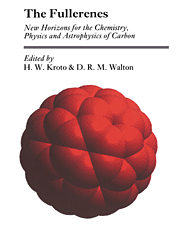Book contents
- Frontmatter
- Contents
- The evolution of the football structure for the C60 molecule: a retrospective
- Dreams in a charcoal fire: predictions about giant fullerenes and graphite nanotubes
- On the formation of the fullerenes
- Production and discovery of fullerites: new forms of crystalline carbon
- Systematics of fullerenes and related clusters
- The fullerenes: powerful carbon-based electron acceptors
- The carbon-bearing material in the outflows from luminous carbon-rich stars
- Elemental carbon as interstellar dust
- The pattern of additions to fullerenes
- Pollyynes and the formation of fullerenes
- Hypothetical graphite structures with negative gaussian curvature
- Fullerenes as an example of basic research in industry
- Deltahedral views of fullerene polymorphism
- Geodesic domes and fullerenes
The fullerenes: powerful carbon-based electron acceptors
Published online by Cambridge University Press: 03 February 2010
- Frontmatter
- Contents
- The evolution of the football structure for the C60 molecule: a retrospective
- Dreams in a charcoal fire: predictions about giant fullerenes and graphite nanotubes
- On the formation of the fullerenes
- Production and discovery of fullerites: new forms of crystalline carbon
- Systematics of fullerenes and related clusters
- The fullerenes: powerful carbon-based electron acceptors
- The carbon-bearing material in the outflows from luminous carbon-rich stars
- Elemental carbon as interstellar dust
- The pattern of additions to fullerenes
- Pollyynes and the formation of fullerenes
- Hypothetical graphite structures with negative gaussian curvature
- Fullerenes as an example of basic research in industry
- Deltahedral views of fullerene polymorphism
- Geodesic domes and fullerenes
Summary
The gaseous, solution and solid state experimental evidence for electron addition to the fullerenes is reviewed and it is shown that this class of molecules function as powerful electron acceptors. The topological character of C60 as described by Hiickel molecular orbital theory suggests that the molecule will undergo facile reduction, but comparisons with planar conjugated hydrocarbons show that this feature alone cannot account for the very low half-wave reduction potential of C60. Because of the curvature of the surface, fullerene hybridization falls between graphite (sp2) and diamond (sp3) and these new carbon allotropes are therefore of intermediate, and perhaps variable hybridization. According to POAVI theory the carbon atoms in C60 are of sp2.28 hybridization. It is concluded that rehybridization plays an important role in determining the electronic structure of the fullerenes and it is the combination of topology and rehybridization that together account for the extraordinary ability of C60 to accept electrons.
Introduction
The ability of the fullerenes to function as electron acceptors has been recognized since the first investigation of their chemistry (Haufler et al. 1990). Even before the isolation of bulk quantities of C60 (Kratschmer et al. 1990), a large electron affinity was demonstrated for this molecule in gas phase experiments (Curl & Smalley 1988).
This trend has continued with the development of the physics, chemistry and materials science of the fullerenes. In this paper some of the experiments that have thrown light on the ability of the fullerenes to accept electrons are summarized and qualitative explanations for their extraordinary electron affinity are discussed.
- Type
- Chapter
- Information
- The FullerenesNew Horizons for the Chemistry, Physics and Astrophysics of Carbon, pp. 53 - 62Publisher: Cambridge University PressPrint publication year: 1993
- 7
- Cited by



